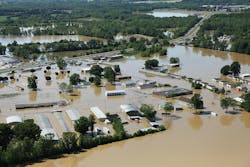New bill would limit housing sprawl in fire- and flood-prone areas of California
A new bill in the California Assembly would limit housing sprawl in fire- and flood-prone areas across the state.
For the last several decades, new housing has spread to more remote areas of the Golden State. This trend has allowed people to live closer to nature and buy homes in more affordable areas, but it’s also left millions vulnerable to wildfires and flooding.
About a quarter of all state residents live in areas at risk of catastrophic fire and one in five residents live in areas vulnerable to floods, according to estimates. Recently, an “unlikely coalition of environmentalists and housing advocates” has supported a bill intended to slow growth in many parts of the state while encouraging more multifamily housing in existing population centers, according to a report in the San Jose Mercury News.
The bill wouldn’t ban new housing in risky regions or prevent people in those areas from rebuilding their homes after disaster strikes. But it would restrict certain large master-planned developments by defining “hazard areas” across the state. Local officials wanting to approve more homes than their general plans allow for in those locations would have to show that the same number of units couldn’t be built elsewhere in the city or county.
